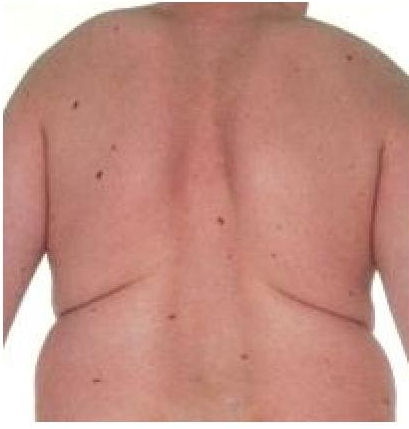Craniospinal RT
EARLY (during treatment and the first month after radiation)
- Anorexia, nausea and vomiting. Ondansetron (Zofran) given half an hour to one hour prior to RT limits this side effect significantly
- Headache due to transiently increased intracranial pressure at the start of therapy
- Mucositis (posterior pharyngeal wall)
- Skin erythema within the treatment field and dry desquamation
- Alopecia
- Bone marrow suppression with low counts
EARLY DELAYED (up to 6 months after therapy)
Scattered astrocytic and microglial reactions, perivascular collections of mononuclear cells and demyelination seen.
- "Somnolence syndrome" and Lhermitte's sign. Both are possibly due to transient demyelination and start 6 - 8 weeks after the end of RT.
- The somnolence syndrome lasts for about 2 weeks (there are no consistent CT changes and diffuse slow wave activity on the EEG).
- These side effects are actually more common for children having treatment for acute leukemia – possible relationship with methotrexate administration.
LATE (90 days to many years after therapy)
Many factors determine the severity of late effects. These include:
- Patient factors:
- Age at the time of RT
- Individual genetic and familial factors
- Disease factors:
- Region where tumor has arisen and RT sensitivity of the organ or part of organ that needs therapy
- Treatment factors:
- RT related
- Quality of the radiation
- Dose per fraction and total dose RT
- Volume of normal tissue irradiated
- Concurrent therapies received (surgery and chemotherapy).
- RT related
Many large studies of pediatric cancer survivors have shown long term neurologic, neurocognitive, endocrinologic, and neuropsychologic deficits.
Below is a summary of some late effects. A thorough summary of guidelines around management and surveillance as well as patient education can be found at www.survivorshipguidelines.org, published by the Children’s Oncology Group.
General
- Permanent alopecia in the scalp immediately adjacent to the high dose RT volume.
- Reduced bone marrow reserve (chemotherapy may be poorly tolerated if given later).
- Cataracts (lens usually gets less than 15% of the cranial dose).
- After craniospinal RT patients will have a short sitting height (reduced vertical growth of vertebral bodies) and an increased risk of scoliosis.
- Radiation to the whole brain can result in a disproportionately small cranium.
- Scoliosis and kyphosis are in part due to uneven growth of the paravertebral muscles after RT and not only due to the effect on bone growth alone.
- Damage to bone is most likely due to direct damage to proliferating chondroblasts, leading to arrest and destruction.
- Intermitotic chondroblasts are the most sensitive cells in the skeleton, while osteoblasts are much less sensitive.
- There is also vascular injury leading to impaired bone and cartilage reabsorption.
- The epiphysis-physis portion of a long bone is the most sensitive.
- The effect of RT on bone growth depends on the dose of radiation given and how old the child is at the time of therapy. There is little alteration in bone growth with total fractionated doses of less than 10 Gy. Doses of 10-20 Gy produce partial growth arrest often with transverse bone lines and doses much greater than 20 Gy are required to completely arrest endochondrial bone formation.
Below is a clinical photograph showing profound hypoplasia of the spine and paravertebral tissues arising many years after craniospinal RT in young child.

- Thyroid damage
- primary hypothyroidism is very common (threshold at 2500-3000 cGy).
- These patients must have their thyroid function tests checked at least on an annual basis in the long term.
- There is a significantly increased risk of development of benign thyroid nodules and papillary carcinoma of the thyroid many years later.
- Pituitary/Hypothalamus damage
- Threshold at 24-29 Gy and growth hormone is impaired first.
- Usually these children require growth hormone replacement therapy in the long term (see cranial section).
- Gonads
- Infertility is a risk after craniospinal radiotherapy. Overall the risk is probably in the 10 - 20% range.
- Male gets less than 10% of TD.
- Female gets 5 - 80% of the TD depending on the position of the ovaries.
- See Cranial Section

